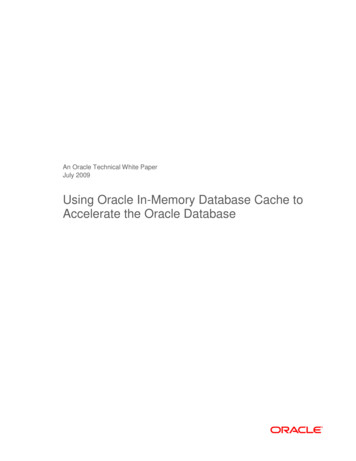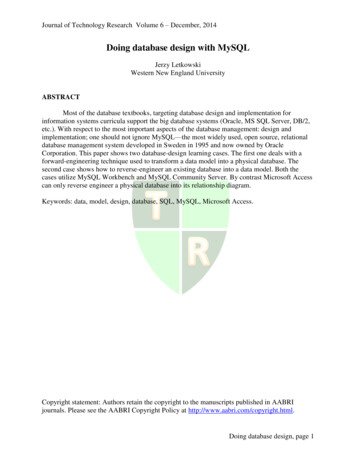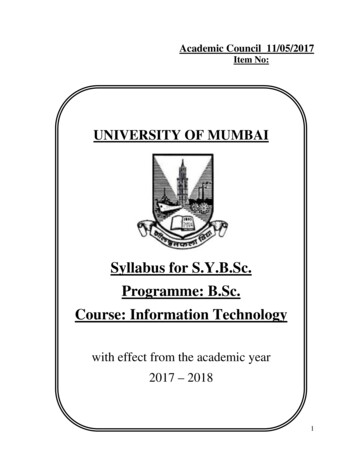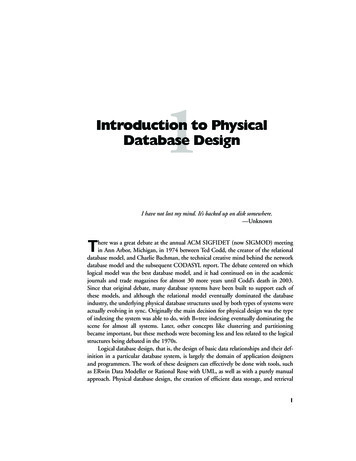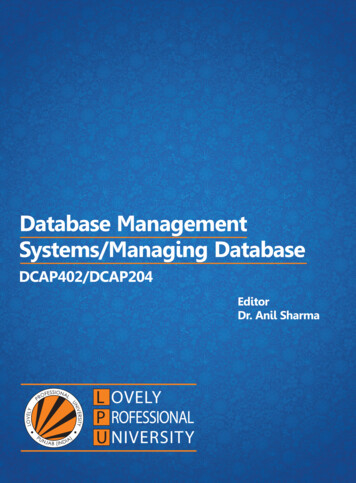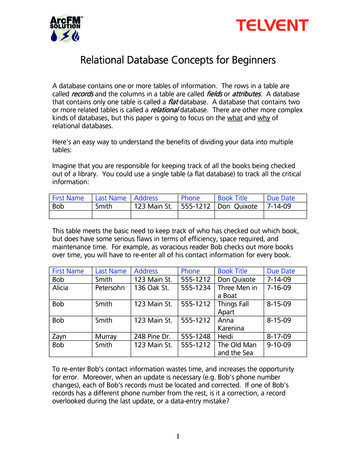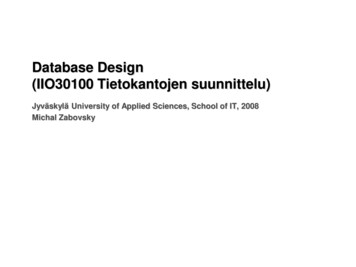
Transcription
Database Design(IIO30100 Tietokantojen suunnittelu)Jyväskylä University of Applied Sciences, School of IT, 2008Michal Zabovsky
Overview about Database design Database design and data modeling- Data modeling using CASE tools- Entity-relationship models- Toad Data ModelerPractical issues Real examples Data models for different database systems
Database designTo build good application systems, design must proceed in a set oforderly steps using proper techniques at each step. Such techniquesmust be chosen so that the output of one step can be used as the inputfor the following step.Design methodologies are collections of techniques organized into set ofsteps that supports an orderly way for designing database.Design methodologies also provide the documentation necessary torecord any design decisions. Many methodologies now provide softwaresupport or CASE (Computer Assisted Software Engineering) tools tosupport designers and maintain the documentation.
Toad Data Modeler
Data representationOverall efficiency of RDBMS is the essential requirement of databasedesign. Hence decision, which data type would be used for datarepresentation is critical and should be retained on the databasedesigner consideration.We should consider about:- numerical data representation (often is necessary to define accuracy or range)- character data representation (different encoding can be used)- data encoding (e.g. 1 Red, 2 Green etc.)- units for numeric data- data materialization- structure of stored records- structure of stored files
Data modelingData modeling is the act of exploring data-oriented structures. Like othermodeling artifacts data models can be used for a variety of purposes,from high-level conceptual models to physical data models.Two main types of models:- Logical models - used in DBMSs for the organization of data at a \level thatabstracts from physical structures. Examples: relational, network, hierarchical,object- Conceptual models: used to describe data in a way that is completelyindependent of any system, with the goal of representing the concepts of thereal world; they are used in the early stages of database design. The mostpopular is the Entity-Relationship modelData models used in practice:- Conceptual data models (CDM)- Logical data models (LDM)- Physical data models (PDM)
Conceptual modelOne of the most difficult problem during the design phase istransformation of data to information stored in the database. Theproblem grows with the very weak process formalization. Data itselfprovides just partial information, hence additional description must becreated by the conceptual model. This description must followconceptual view of users to the particular real world part.Conceptual design works with terms like entity, object, relation,attribute, property etc. Since the terms are close to real world themodels are sometimes called object-oriented models.Each conceptual model solves three problems:- Data structure- Data manipulation- Data integrity
Logical modelLogical model is used to explore:- Domain concepts- RelationshipsThis could be done for the scope of a single project or for entireenterprise.Logical model identifies:- Logical entity types, typically referred to simply as entity types- Data attributes describing those entities- Relationships between the entities
Physical modelPhysical model is used to design the internal schema of database.Physical model depicts:- Data tables- Columns- RelationshipsPhysical data model shows greater detail, including an associative tablerequired to implement the association as well as the keys needed tomaintain the relationships.PDM should also reflect database naming standards and indicate thedata types for the columns, such as integer and char(5).
Logical and physical data model
Entity-Relationship modelEntity-relationship model (E-R model) helps to describe user’sapplication on the conceptual level - defines top-level data semantics. Itidentifies the most important entities and relationships in the data.The next step is to construct a set of normalized relations. This set ofrelations removes any unnecessary redundancy. Then the logicaldefinition is created.The form of the definition depends on the database managementsoftware that is to be used to implement the database. It defines thedatabase schema using the DBMS data definition language.
How to model data?1.2.3.4.5.6.7.8.Identify entity typesIdentify attributesApply naming conventionsIdentify relationshipsApply data model patternsAssign keysNormalize to reduce data redundancyDenormalize to improve performance
Toad – new model
E-R model elementsEntity is the real life object instance that is considered to be importantin a system.Example: “student Peter Novák, born number 123456/7890“Entity set is a collection of objects with the same properties.Relationship models connection between one or more entities (way,how entities interact with each other).Example: entity „student Peter Novák, born number 123456/7890“interacts (“attend”) with entity “course Database Systems“Attributes describe the properties of entities and relationships.An entity identifier is and attribute (or set of attributes) whose valuesidentify a unique entity. Identifiers are either unique (single attribute) orcomposite (made up of more than one attribute).
Toad – new entity
IdentifiersSo far, we have made a distinction between entities and entity sets. ER diagrams only include sets but not individual entities. However, onerequirement of all systems is to be able to identify individual entitieswithout necessarily showing them on the E-R diagram. Suchidentification is needed to determine the activities carried out by theentities. The usual practice is to identify entities by an entity identifier.An entity identifier is an attribute (or set of attributes) whose valueidentifies a unique entity.Since entity can have more then one candidate for identifier, isnecessary to choose such identifier which is the best for efficiency ormemory consumption.
Toad – primary key
AttributesAttributes describe the properties of entities and relationships. Each suchattribute is given a name which refer to a particular property.Each attribute is characterized by:-nametypeflag, whether the attribute is part of identifierflag, whether the value could be undefined (NULL)flag, which specifies the unique value for attribute
Toad – attributes
CardinalityCardinality shows the number of relationships in which one entity canappear.Cardinality 1:1 - entity can participate in only one relationship. In thecase that both entities are of the same type relationship is calledrecursive.Example: person -drives- carCardinality 1:N – entity from one set can participate in more than onerelationship.Example: person –use - carCardinality M:N – each entity from one set can participate in more thanone relationship.Example: teacher - teaching - subject
ParticipationParticipation is an additional information that is often stored aboutrelationship. This describes whether each entity in a set must participatein a relationship. Participation can be either mandatory or optional.Department must have teacher and each teacher must be assigned todepartment.teacher - has - departmentTeacher must have department and department need not to haveteacher.teacher - has -O departmentDepartment need not to have teacher and teacher need not to havedepartment.teacher O- has -O department
Relationships Identifying relationship (1:1) - Primary key migrates from the parent entity tothe child entity and there becomes a part of the primary key. It is used when theprimary key of the child entity is unable to provide definite identification. Anentity, connected with a parent entity through an identifying relationship, is calleda dependent entity and is shown in a model with rounded corners. Nonidentifying relationship (1:N) - Primary key migrates from the parent entityto the child entity and does not become a part of the primary key. This kind ofrelationship is often called master-detail relationship. Many-to-many relationship (M:N) - Most of the RDBMS is not able to representrelationship M:N directly. Also other reasons lead to decomposition to the tworelationships of 1:N type. Informative relationship - Primary key does not migrate at all, no referentialintegrity or triggers are generated, it is only information about the existence ofsome relationship. Self relationship - In most cases this kind of relationship is used to modelhierarchy – e.g. relationship children – parents.
ExampleObjectives:Create data model for the information system of faculty. In the IS wewant to store necessary information about:-studentsteachersattended coursesspecializationsSteps:1. Create entities person, student, attended courses, branch, course andteacher2. Define attributes for entities3. Create relationships, define participation4. Define physical data types for attributes
What will be done?
Step 1: Entities
Step 2: Attributes
Step 3: Relationships
What's next?When the logical and consequently physical model is designed, wholemodel can be implemented on particular database system.Implementation consists of following steps:-Database system installationDatabase configuration and tuning based on particular usageDatabase and relations creationData import or creationUser and access configurationArchiving and monitoring system configuration
Bibliography1.Atzeni, P., Ceri, S., Paraboschi, S., Tarlone, R.: Database Systems – Concepts, Languages andArchitectures, McGraw-Hill, 1999
UNIVERSITY OF ZILINAFACULTY OF MANAGEMENT SCIENCE AND INFORMATICSDEPARTMENT OF INFORMATICSUniverzitna 8215/1SK-01026, Zilina, Slovak RepublicPhone: 421-41-513 4181Fax: 421-41-513 4055Homepage: http://www.fri.uniza.skIng. Michal Zábovský, PhD.michal.zabovsky@fri.uniza.skDepartment of InformaticsFaculty of Management Science and InformaticsUniversity of ZilinaIntroductionThe Department of Informatics comprises around 20academics and research fellows who form researchcommunity in Computer Science. Its complement of peopledirectly involved in research is close to 50. The Departmentis strongly involved in many practical collaborativeindustry projects and research projects on national andinternational level.ResearchResearch addresses the fundamentals of computersystems, architectures, database systems and informationanalysis. The key research topics cover distributed andparallel systems and advanced database systems.
Entity-Relationship model Entity-relationship model (E-R model) helps to describe user's application on the conceptual level - defines top-level data semantics. It identifies the most important entities and relationships in the data. The next step is to construct a set of normalized relations. This set of relations removes any unnecessary .


